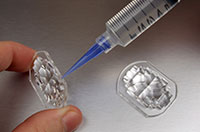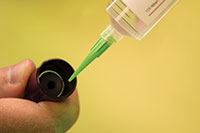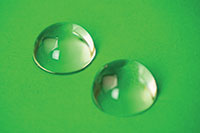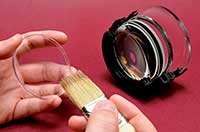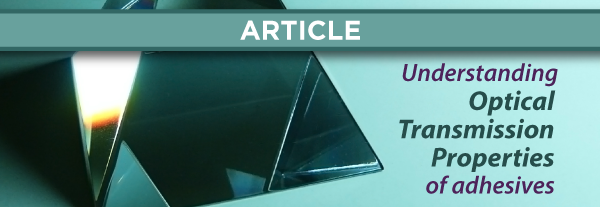 |
Optical transmission is the ability for light to be channeled through a material, and it is measured from 0 to 100% on a wavelength scale of approximately 200 to 3,100 nanometers (nm). This property is essential for a number of applications in the optical and electro-optical industries. Most optically clear epoxies, polysulfides, and silicones offer excellent light transmission across the visible and near IR ranges, with select systems providing high transmission in the UV and in the middle IR wavelength ranges. This article explains optical transmission and provides specific examples of products that excel in this area.

|
|
EP30: Low Viscosity, Optically Clear Two Part System |
Featuring superb strength characteristics, EP30 bonds well to a variety of substrates including metals, glass, ceramics, many plastics and rubber materials. This highly dimensionally stable system has very low shrinkage after cure, less than 0.003 in./in. Its low viscosity enables this system to be used for bonding surfaces with tight clearances. The product features outstanding chemical resistance, hardness and superb optical clarity.
For more information, request a technical data sheet on EP30
|
| MasterSil 151: Optically Clear, Water Resistant, Addition Cured Silicone System |
|
For potting applications where low exotherm and high flexibility are required, MasterSil 151 is an ideal candidate. Featuring outstanding electrical insulation properties and a low viscosity, MasterSil 151 also provides superior resistance to vibration and shock. This high strength compound has an elongation of 120-150% and very low shrinkage upon cure. Serviceable over the wide temperature range of -65°F to +400°F, MasterSil 151 also offers convenient handling. It has the ability to cure at room temperature or faster at elevated temperatures. Specialty uses include encapsulating LEDs, optical fiber cladding and potting connectors.
For more information, request a technical data sheet on MasterSil 151
|
| MB600: One Part Sodium Silicate System Resists High Temperature |
MB600 is an aqueous based sodium silicate system for bonding and coating. This one component low viscosity adhesive is capable of withstanding temperatures up to 1,500°F. It is optically clear and has very special light transmission properties, particularly in the range of 200-350 nm. MB600 is a competent electrical insulator, offers rigidity, excellent dimensional stability and provides a barrier to moisture.
For more information, request a technical data sheet on MB600
|
| UV15: Exceptionally High Glass Transition Temperature |
Cationic curing systems, such as UV15, tend to have much higher temperature resistance than other UV type systems. Its glass transition temperature (Tg) with a straight UV cure is 90-95°C, and when post cured for 30 minutes at 125°C, the Tg is 125-130°C. This post cure also enhances UV15’s chemical resistance. The halogen free adhesive meets IEC 61249-2-21 standard and has a service temperature range of -80°F to +350°F. It also withstands 1,000 hours at 85°C/85% RH.
For more information, request a technical data sheet on UV15
|
|
|
|
Copyright  2017 by Master Bond Inc. All Rights Reserved. This content may not be reproduced in any way without the prior written permission of Master Bond Inc. 2017 by Master Bond Inc. All Rights Reserved. This content may not be reproduced in any way without the prior written permission of Master Bond Inc.
|
|
 View this email online
View this email online



 July 2017
July 2017
